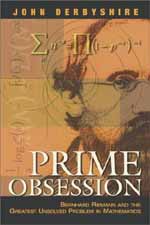Two books about primes
 |
Prime obsession: Bernhard Riemann and the greatest unsolved problem in mathematicsJohn Derbyshire |
 |
The music of the primes: why an unsolved problem in mathematics mattersMarcus du Sautoy |
Early in our mathematical careers, we are introduced to prime numbers. These special integers, which possess no divisors other than themselves and 1, are the building blocks for all the integers. Thus an understanding of the properties of primes, including where to find them, is an essential part of number theory, and any serious discussion of prime numbers will inevitably lead to what is arguably mathematics' greatest unsolved problem: The Riemann Hypothesis.
The technical statement of the hypothesis is: "The non-trivial zeros of Riemann's zeta function all have a real part of one half". This was first conjectured by Riemann in 1859 and since then has neither been proved nor disproved. The implications of a proof for the theory of prime numbers would be huge. As usual with such subjects, though, the non-expert needs to be introduced to many other "mathematical preliminaries" in order to get closer to understanding both the hypothesis and its implications. Two books which could help, albeit in different ways, are John Derbyshire's Prime Obsession and Marcus du Sautoy's The Music of the Primes.
In Prime Obsession, Derbyshire goes some way towards helping the non-mathematician understand what the statement of the hypothesis actually means. From the very beginning he provides numerous illustrative examples, allowing the reader to grasp just enough before moving on to the next concept. For example, in the first chapter he gives examples of several different infinite series - these are never-ending sums - some of which converge (that is, add up to some number) and others which diverge (that is, become arbitrarily big as you add more and more terms). He provides very nice concrete manifestations of these series, involving cards, rulers and other "tools".
After setting up these essential ideas, Derbyshire quickly moves on to the central question in prime number theory - namely, how many primes there are less than any given number. Remarkably, we can only give an approximate answer to this question: a mathematical result known as the "Prime Number Theorem". This result was first noticed by Gauss, but only proved about 100 years ago using the sophisticated tools created by another great mathematician, Riemann. Riemann saw that the difference between Gauss's guess for the number of primes less than some given number, and the "true" number, can be described by the points at which a special function called the "zeta function" takes the value of zero. Derbyshire really goes all out on trying to give the reader a feel for this rather exotic function. He provides graphs sketching different parts of the function, and even "walkthroughs" where he guides the reader over the complex (literally!) landscape created by this magical function.
The book is very well structured, and well-written in an informal style. Its quirkiness is a clear indication that the author is a mathematician - Derbyshire's passion for the subject comes through. The book seems to be written for "interested A-level students", and caters very successfully to this intended audience - there are certainly enough equations to intrigue the curious reader. Interleaved with the maths is some historical background on the central players of the subject, such as Euler, Gauss and, of course, Riemann himself.
However, if you want a more thorough account of the people involved in research on prime numbers through the ages, then perhaps Marcus du Sautoy's The Music of Primes is the book for you. It is a very gentle read, and does not really attempt to explain the mathematics involved. But if you want an overview, not so much of primes, but their importance in the modern world, their unexpected apparent connection with quantum physics, and all the mathematicians they have taunted over the centuries, this book will not disappoint.
Du Sautoy is a also a mathematician - a professor of mathematics at Oxford - but his agenda clearly differs from Derbyshire's. This book is more accessible to the non-mathematician, because it does not overwhelm the reader with the mathematics, and uses analogies throughout to keep the reader comfortable. For example, there is, of course, a strong musical theme (hence the title). Du Sautoy emphasises that the distribution of prime numbers is intimately related to the notes provided by a mathematical drum - the zeta function - and that the Riemann hypothesis is the statement that all the notes contribute equally loudly to the "music of the primes".
In summary, if you want to get a taste of some of the most beautiful mathematics that humans have invented, then Derbyshire's book is probably where you should look. If, however, you don't mind glossing over the nitty-gritty, then you should let du Sautoy tell you about one of the most fundamental, yet ferociously difficult, areas in mathematics - prime numbers.
|
|